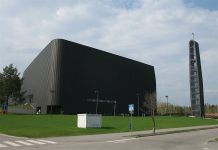Klaukkala (Finnish: [ˈklɑu̯ˌkːɑlɑ]; Swedish: Klovskog [ˈklôːvskuːɡ], Finland Swedish: [ˈkloːvskuːɡ]) is a large town-like village in the southern part of the Nurmijarvi municipality of Uusimaa, Finland, near Lake Valkjarvi. It is the largest of the villages in Nurmijarvi and often mistakenly thought to be a separate town. In the 2010s, Klaukkala's urban area (Finnish: taajama) grew to be part of the Helsinki urban area.
Klaukkala has a population of over 18,000 and is the fastest-growing area of Nurmijarvi; almost half of the total population of the municipality lives in Klaukkala. Its population began to rise in the 1960s, when it surpassed the church village of Nurmijarvi. In the 1970s, Klaukkala also grew larger than Rajamaki, which until then was the largest of Nurmijarvi's villages. At that time, Klaukkala's population was over 2,500. Nowadays, the population of the Klaukkala is even larger than three municipalities in Uusimaa: Hanko (8,064), Karkkila (8,696) and Loviisa (14,741). Klaukkala has significant migration mainly from the Helsinki conurbation; being a rural village a half-hour's drive away from the Helsinki centre, it especially attracts families with children. Unfortunately, due to the enormous population growth, the village is also infamous for its growing traffic, which causes local problems at the mornings and afternoons.
In the early 2000s, many detached houses were built in Klaukkala, but the situation has changed as up to three-quarters of the new houses are apartment, terraced and semi-detached houses.
History
Early history
The earliest references to Klaukkala date back to the 16th century, at which time the village was part of the Helsinki parish (Finnish: Helsingin pitaja). The earliest inhabitants were mainly tavastians. In the 1540s there were as many as 11 houses in Klaukkala, which together constituted five full taxes: Viiri, Tilkka, Gunnari, Olli, Huitti, Seppala and Klaukka, which was the oldest house in the village.
